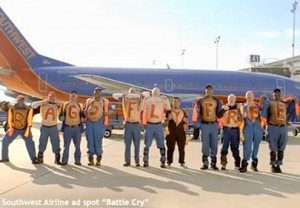Disgruntled Employees? Try Putting Them First
A few years ago I read the book Employees First, Customers Second.The author, Vineet Nayar, writes about his account of transforming HCL Technologies, a global IT services company based in India.
 As a typical top-down driven organization the company was transformed into one that became driven by employees, working in what they call the “value zone” – the place where customers interface with the company. Based on this “employee first” approach, HCL Technologies became one of the fastest growing firms in the global IT services industry.
As a typical top-down driven organization the company was transformed into one that became driven by employees, working in what they call the “value zone” – the place where customers interface with the company. Based on this “employee first” approach, HCL Technologies became one of the fastest growing firms in the global IT services industry.
How did Nayar do it? He writes:
“There we were, the senior leadership team, standing up in front of the entire company, taking all questions, opening ourselves to every comment. Just by being available and by being transparent as we could be in our comments and answers, we built trust with the members of the audience.”
Is that it – being available and willing to take questions, and then responding with honesty and transparency?
Yes, it’s that easy. And it’s that difficult.
It takes a lot of courage for leaders to be fully transparent – and show both personal and professional vulnerability. Yet, it’s exactly what’s required to build trust with employees – and customers.
In fact, sometimes it’s easier to start with customers.
Learning from a Corporate Apology
 In January 2015, I wrote about a public apology by the CEO of Intuit, after the company made a negative change to the CD/download version of their extremely popular TurboTax desktop software. Customers were suddenly forced to upgrade their version of TurboTax, even though their tax situation hadn’t changed from the year before. And key tax schedules were suddenly gone.
In January 2015, I wrote about a public apology by the CEO of Intuit, after the company made a negative change to the CD/download version of their extremely popular TurboTax desktop software. Customers were suddenly forced to upgrade their version of TurboTax, even though their tax situation hadn’t changed from the year before. And key tax schedules were suddenly gone.
When I analyzed the CEO’s apology, what I found were a few key elements:
- Transparency. The CEO showed his willingness to be vulnerable, and explain what went wrong.
- Direct and respectful. The CEO stayed true to this promise.
- Lead with a hypothesis. The CEO highlighted the fact they tried an idea, it failed and then outlined how they were going to fix it.
- Measure and act on what matters most. The CEO stated that they heard from a lot of customers over a 2-week period, and more importantly, were willing to act on the feedback.
- Speak the truth and assure best intent. The CEO clearly outlined what they did and why they did it, and what they learned from it.
- Accountability. The CEO took full responsibility for the company’s actions, and committed to re-earning the trust of customers.
In other words, through this apology process Intuit’s CEO was setting an example for all employees on how to behave in front of customers AND with each other.
But what if the customer is wrong?
The Power of Employees First
One of the stories I like to share with audiences that always gets a chuckle is from Herb Kelleher, the co-founder and Chairman Emeritus of Southwest Airlines.
As the story goes, Kelleher received a complaint letter from a disgruntled customer suggesting the humorous antics of flight attendants were highly inappropriate, while describing the safety procedures before takeoff (e.g. “In the event of a landing on water we will bring round fresh towels and cocktails”). So how did Kelleher handle this complaint? He sent a letter of reply with just three words on it: “We’ll miss you!”
While most companies would have responded with a letter of apology (and chastised the flight attendant), Kelleher did something far more significant. He sent a clear message to all his employees that they come first!
[Hint: The power of this story is proven in the fact it continues to get shared. It’s now become part of the mythology of working at Southwest]
It’s all in the Attitude
 This spirit of employee-first is captured best in one of the four core values of Southwest Airlines: Fun-LUVing Attitude. To clarify what this means, the company lists the following key points:
This spirit of employee-first is captured best in one of the four core values of Southwest Airlines: Fun-LUVing Attitude. To clarify what this means, the company lists the following key points:
- Have FUN
- Don’t take yourself too seriously
- Maintain perspective
- Celebrate successes
- Enjoy your work
- Be a passionate Teamplayer
It’s important to note that the issue of safety is built into one of the other values (Work the Southwest Way). But the secret sauce of Southwest Airlines has always been their people.
If employees feel the love from management, they in turn will share their fun-LUVing attitude with customers, which then makes for (mostly) happy customers. In addition, a “fun” environment also translates into financial benefits for the company through lower employee turnover.
So how does Southwest manage to consistently accomplish this?
In the book, The Southwest Airlines Way the authors suggest that the key ingredient to Southwest’s success is its ability to build and sustain high performance relationships among managers, employees, unions, and suppliers. I think that’s just a fancy way of saying “employees come first.”
So, if you are struggling with disgruntled employees, maybe it’s time to be a little more transparent, show some vulnerability, and put your employees first!









